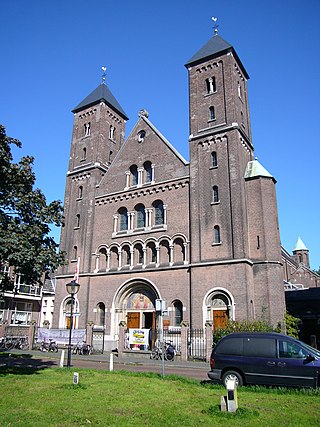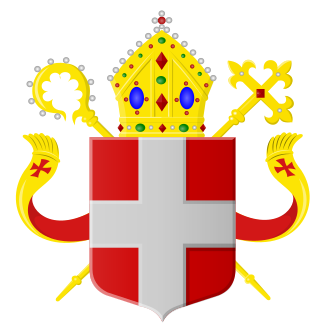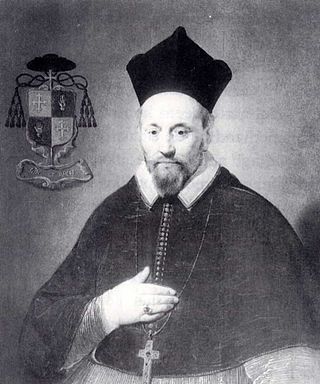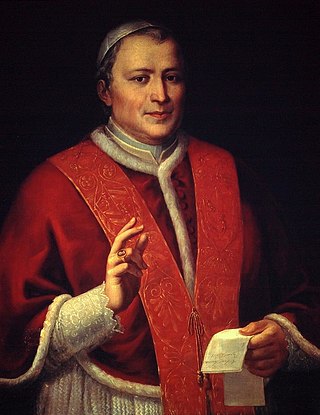
The Old Catholic Church of the Netherlands, sometimes Jansenist Church of Holland, is an Old Catholic jurisdiction originating from the Archdiocese of Utrecht (695–1580). The Old Catholic Church of the Netherlands is the mother church of the Old Catholic Union of Utrecht.
An apostolic administration in the Catholic Church is administrated by a prelate appointed by the pope to serve as the ordinary for a specific area. Either the area is not yet a diocese, or is a diocese, archdiocese, eparchy or similar permanent ordinariate that either has no bishop or archbishop or, in very rare cases, has an incapacitated (arch)bishop. The title also applies to an outgoing (arch)bishop while awaiting for the date of assuming his new position.
The hierarchy of the Catholic Church consists of its bishops, priests, and deacons. In the ecclesiological sense of the term, "hierarchy" strictly means the "holy ordering" of the church, the Body of Christ, so to respect the diversity of gifts and ministries necessary for genuine unity.

The Archdiocese of Utrecht is an archdiocese of the Latin Church of the Catholic Church in the Netherlands. The Archbishop of Utrecht is the metropolitan of the ecclesiastical province of Utrecht. There are six suffragan dioceses of the province: Roman Catholic Dioceses of Breda, of Groningen-Leeuwarden, of Haarlem-Amsterdam, of Roermond, of Rotterdam, and of 's-Hertogenbosch. The cathedral church of the archdiocese is Saint Catherine's Cathedral, which replaced the prior cathedral, Saint Martin's Cathedral after it was taken by Protestants in the Reformation.

Johannes Zwijsen was a Dutch Catholic prelate who served as the first Archbishop of Utrecht after the reestablishment of the episcopal hierarchy in the Netherlands in 1853.
The Holland Mission or Dutch Mission was the common name of a Catholic Church missionary district in the Low Countries from 1592 to 1853, during and after the Protestant Reformation in the Netherlands.

The Diocese of Haarlem–Amsterdam is a Latin diocese of the Catholic Church in the Netherlands. As one of the seven suffragans in the ecclesiastical province of the Metropolitan Archbishop of Utrecht, the diocesan territory comprises the north west of the Netherlands, including the cities of Haarlem and Amsterdam.

The Archdiocese of Cape Town is a Latin Church ecclesiastical jurisdiction or archdiocese of the Catholic Church located in Cape Town, in the south-western region of South Africa. The principal church of the archdiocese and the location of the archbishop's cathedra is the Cathedral of St. Mary of the Flight into Egypt, which also serves as the patron saint for the archdiocese.

The Diocese of Rotterdam is a Latin diocese of the Catholic Church in South Holland province of the Netherlands. The diocese is a suffragan in the ecclesiastical province of the Metropolitan Archbishop of Utrecht. Since 2011, the bishop has been Hans van den Hende.

The Diocese of 's-Hertogenbosch is a Latin Church ecclesiastical jurisdiction or diocese of the Catholic church in the Netherlands. The modern diocese was created in 1853. It is a suffragan of the archdiocese of Utrecht. It is currently led by bishop Gerard de Korte. Its see is St John's Cathedral, 's-Hertogenbosch.

Frederik Schenck van Toutenburg was the first Archbishop of Utrecht (1559–1580). Prior to Schenck's ministry as archbishop, Utrecht was a bishopric with a succession of sixty bishops. The last bishop of Utrecht, prior to Schenck was George van Egmond. After Schenck's death in 1580, the see would remain vacant until Sasbold Vosmeer assumed the archbishopric in 1602.

Pieter Codde also known as Petrus Codde was apostolic vicar of the Catholic Church's Vicariate Apostolic of Batavia, also known as the Dutch Mission, from 1688 to 1702. He served as the Old Catholic Archbishop of Utrecht from 1688 until his death in 1710.

Johannes Baptista van Neercassel served as apostolic vicar of the Dutch Mission, heir of the Roman Catholic Archdiocese of Utrecht, from 1661 to 1686.

Boudewijn Catz or Cats was apostolic vicar to the Dutch Mission from 1662 to 1663.

Philippus Rovenius was apostolic vicar of the Dutch Mission from 1614 to 1651.

The Lordship of Utrecht was formed in 1528 when Charles V of Habsburg conquered the Bishopric of Utrecht, during the Guelders Wars.

The Bishops' Conference of the Netherlands is a permanent body within the Roman Catholic Church in the Netherlands which determines policies and directs the apostolic mission within the Netherlands. It is governed by bishops from around the country.
The historic Diocese of Utrecht was a diocese of the Latin Church of the Catholic Church from 695 to 1580, and from 1559 archdiocese in the Low Countries before and during the Protestant Reformation.

On 4 March 1853, Pope Pius IX restored the episcopal hierarchy in the Netherlands with the papal bull Ex qua die arcano, after the Dutch Constitutional Reform of 1848 had made this possible. The re-establishment of the episcopal hierarchy led to the April movement protest in 1853.
Giovanni Paolo Marincola was a Roman Catholic prelate who served as Bishop of Teano (1575–1588).















